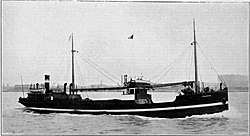Full agar
|
Full agar
|
||||||||||||||||||||||
|
||||||||||||||||||||||
|
||||||||||||||||||||||
|
||||||||||||||||||||||
|
||||||||||||||||||||||
|
||||||||||||||||||||||
The Fullagar was the world's first completely welded ship.
history
The coaster was built from 1917 to 1920 under hull number 882 at the Cammell, Laird & Company shipyard in Birkenhead , Great Britain . The launch took place on February 5, 1920, and on July 2, 1920 the ship was handed over to the British shipping company T. & J. Brocklebank in Liverpool . It was operated on the regular service between Liverpool and Belfast .
In November 1921 the ship was sold to the Manx Isles Steamship Company in Liverpool and renamed Caria . A little later, the Cammellaird Fullagar four-cylinder two-stroke opposed piston diesel engine was replaced by a W. Beardmore four-cylinder two-stroke diesel engine. In June 1925, the Caria ran on a sandbank on the Mersey, where it suffered soil damage. That same year, the British Columbia Cement Company acquired the ship and renamed it Shean . After a last sale to Mexican owners in 1935 and renaming to Cedros , the ship sank on August 31, 1937, 30 nautical miles south of Ensenada , after a collision.
Technical feature
According to the rules of Lloyd's Register of Shipping , which was not established until August 15, 1918 , in which the ship was classified, the Fullagar was almost completely welded, but the plate joints were largely jogged (set down) in the conventional way or just overlapped, such as it was common when joining by riveting .
After its commissioning with the class number as 100 A1 , annual class visits were carried out at Fullagar in the first ten years of operation, in contrast to the normal class run. A stranding, a collision as well as various ground contacts and cases of damage in these first ten years of operation showed that the hull was highly resilient, in some cases far beyond the values of a comparable ship with a conventionally riveted hull. The welded hull was also easier to repair after the damage. In this way, large-scale, deep indentations after the stranding in June 1925 could be removed by hydraulic pressing, which would have meant replacing the affected outer skin panels on a riveted ship. The keel pig was then increased. After a collision in British Columbia , the ship suffered considerable damage, but was not lost, unlike what would probably have happened with the same damage with a riveted structure. Because of these positive experiences and since no unusual susceptibility to rust was observed after ten years of operation, the class run was changed to a two-year interval.
literature
- Motor Ship Fullagar. In: The Engineer. July 16, 1920, p. 69.
- Alfred Dudszus, Alfred Köpcke: The big book of ship types. Weltbild Verlag (licensed edition by transpress, Berlin), Augsburg 1995, ISBN 3-89350-831-7 .
- HP Spratt: Handbook of the Collections Illustrating Merchant Steamers and Motor-Ships (= Science Museum Reprint Series . Part II: Descriptive Catalog ). Her Majesty's Stationery Office by A. Wheaton & Company, Exeter 1968, ISBN 0-901805-01-7 , pp. 89/90 (first edition: 1949, reprint).
Footnotes
- ↑ Data from Fullagar according to the Miramar Ship Index viewed on May 26, 2009.
- ↑ Schw .: Launch of the electrically welded ship “Fullagar” . In: shipyard and shipping company . tape 1 , no. 5 , March 1920, p. 105 .
- ↑ Lloyd's Register: Supplement containing Additions and Amendments adopted by the General Committee since the Issue of the 1917-18 Edition / Notice 1314 . In: Rules and Regulations for the Construction and Classification of Steel Vessels From the 1st July, 1917 to the 30th June, 1918 . August 1918.
- ↑ K .: Operating experience with the electrically welded ship “Fullagar” . In: Werft * Reederei * Hafen . tape 13 , no. January 2 , 1932, p. 28 .
